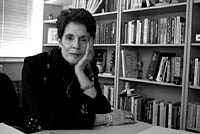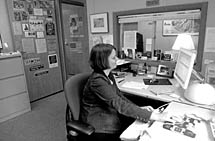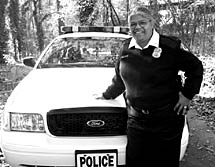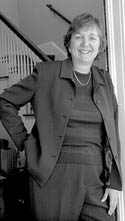The
Emory Women’s Center, as its director
is quick to point out, cannot be all things to all women.
But
in the ten years since the center opened its doors in
a trailer behind Dobbs University Center, that hasn’t
stopped it from trying.
“Looking
back, I don’t know where ten years have gone,”
says Director Ali P. Crown. “But I know I could not
have done it by myself. Every year, we have reached new
people, and there are many who use the Women’s
Center regularly. About four thousand people now attend
our events or use our services on an annual basis. That’s
a lot for two women in a trailer to be taking care of.
I don’t know how we do it, but we have to, so we
do. The Women’s Center is so much bigger than me,
so much more important than one person.”
As
the center’s first and only director, Crown has taken
sixteen hundred square feet and an assistant and, from
these modest beginnings, spun a wide web of support and
community for Emory women, from faculty to freshmen and
secretaries to senior staff. One of the most notable aspects
of the Emory Women’s Center is that it seeks to serve
not only female students, but all women on campus, making
it both a backdrop for scholarly exploration and a community
resource. With a wide-ranging mission to provide services
and educational programs, advocate for women throughout
the University, promote social and professional equality,
and serve as “a forum for women’s cultural,
spiritual, aesthetic, intellectual, and social life,”
the trailer has become a hub of feminine energy. The Women’s
Center marked its tenth anniversary with a gala celebration
in December–both a milestone to be savored, and an
opportunity to take stock.
“The
Emory Women’s Center has secured for women at Emory
a locus of activity and a haven for thought and respite,”
says University President William M. Chace. “I am
inspired by its past, but I am more interested in opening
up its future than in idolizing its achievements. For
such a place, the years that will really count are in
the future.”

Women
whose institutional memories
reach back to the 1960s and ’70s recall
that there were scant resources available for the minority
gender on campus. During “Conversations with Six
Notable Emory Women,” a panel discussion hosted last
fall by the Women’s Center in observance of its tenth
anniversary, Director of Educational Studies  Eleanor
Main (left) remembered coming to Emory in 1969 as an assistant
professor of political science, one of six women on the
entire College faculty. Women students were heavily outnumbered,
too, as Emory College had been coed only since 1953. The
Women’s Caucus, a small group of faculty, staff,
and graduate students that met informally over weekly
brown bag lunches in the early 1970s, discussed myriad
issues including child care, pay equity, safety, and equal
access to University resources–restrooms, for instance.
Some buildings had only one ladies’ room, tucked
away in a remote corner of an upper floor.
Eleanor
Main (left) remembered coming to Emory in 1969 as an assistant
professor of political science, one of six women on the
entire College faculty. Women students were heavily outnumbered,
too, as Emory College had been coed only since 1953. The
Women’s Caucus, a small group of faculty, staff,
and graduate students that met informally over weekly
brown bag lunches in the early 1970s, discussed myriad
issues including child care, pay equity, safety, and equal
access to University resources–restrooms, for instance.
Some buildings had only one ladies’ room, tucked
away in a remote corner of an upper floor.
In
1976, the President’s Commission on the Status of
Women (PCSW) was established by President Sanford S. Atwood,
a year before James T. Laney took the University’s
helm. It has served as an influential advisory body to
the president ever since and helped advance women at the
University on many fronts. But the going was sometimes
painfully slow. When Robyn Fivush, Samuel Candler Dobbs
Professor of Psychology, came to Emory some eight years
later, the Women’s Center, the
Institute for Women’s Studies, and the Clifton
Childcare Center–now vital resources for many Emory
women–had yet to materialize. Fivush was one of only
four new female faculty members hired in 1984. In her
first departmental meeting, she looked around to find
she was one of two women in a room of twenty men. “I
thought, ‘Oh my God, what have I done?’ ”
she says.
Although
the idea of a place just for women had been discussed
among PCSW members and administrators for some time, it
was ultimately concern for the safety of Emory women that
served as the catalyst for the creation of the Emory Women’s
Center. During one weekend in January 1990, two date rapes
were committed by male students on the Emory campus, shocking
the community. President Laney swiftly formed a Task Force
on Security and Responsibility to study the shortcomings
of campus security and recommend solutions. The task force
suggested establishing a “safe space,” among
other measures.
At
that time, Crown had been at Emory for more than a decade,
serving as associate director for executive education
and special assistant to the dean at Goizueta Business
School, as well as holding posts in the law and medical
schools. She also had been a member of the President’s
Commission since 1980. “Ever since I arrived on campus
I’ve been rabble-rousing for women,” says Crown,
who was named director of the Women’s Center in 1991
following a national search.
“Because
I am the first director,” Crown says, “it has
been not just my responsibility but my privilege to set
the tone and culture for the center.”
“Personally,
I feel that the Women’s Center is the main reason
I came back to Emory for a second semester,” she
says. “I really felt that I wasn’t receiving
the kind of support I was looking for and was not finding
a community of women who could address what I wanted to
talk about–the low level of feminist activism on
campus, and the lack of diversity in terms of race and
ethnicity. I literally found the Women’s Center by
mistake, and Ali was there and free and able to talk,
which was great.”
Lowry
had stumbled into a place generally humming with activity.
Crown and her staff have worked hard to make the trailer
a comfortable, useful space for the women who come there,
from the extensive three-thousand-volume library to the
bathroom, adorned with female empowerment posters and
health news. The Nursing Nest, a cozy room with soft chairs
and a dim lamp, was designed for nursing mothers who work
or study at Emory. Free consultation with a counselor
is offered weekly, and a massage therapist periodically
sets up shop as well. Even the narrow hallway has become
a historical display, lined with dozens of photos documenting
the center’s triumphs and the progress of Emory women.
Many women, like Lowry, simply wander in, curious or just
looking to talk.
“The
Women’s Center is a very relaxing place,” says
Marisa Picheny, a senior who does work-study in the center,
following in the footsteps of her older sister, Michelle
Picheny ’00C. “There’s always music playing
and candles going, it smells nice, and it’s bright
and very friendly. Everyone who comes in seems to feel
very comfortable there.”
Relaxing
it may be, but the Women’s Center is also a nexus
of feminist activism. The center offers a range of programs
devoted to empowering women, protecting them from violence,
and achieving gender equity in the workplace and the larger
community.
 “There
is no typical day at Emory Women’s Center,”
says Jenny Williams (left), special programs assistant.
“Sometimes it’s very quiet. More typically,
it’s fairly bustling–we have anywhere from two
to four student workers and volunteers in and out, people
coming in to check out books or wanting a tour, a nursing
mother, the phones ringing, and perhaps we have a few
massages scheduled as well. Other days, the traffic is
incredible. And then someone walks in the door in crisis–a
woman getting the runaround when trying to find out about
prenatal care, or with a professional crisis, or with
a friend desperately needing treatment for an eating disorder.
We stop whatever we’re doing to help these women
with whatever they need.”
“There
is no typical day at Emory Women’s Center,”
says Jenny Williams (left), special programs assistant.
“Sometimes it’s very quiet. More typically,
it’s fairly bustling–we have anywhere from two
to four student workers and volunteers in and out, people
coming in to check out books or wanting a tour, a nursing
mother, the phones ringing, and perhaps we have a few
massages scheduled as well. Other days, the traffic is
incredible. And then someone walks in the door in crisis–a
woman getting the runaround when trying to find out about
prenatal care, or with a professional crisis, or with
a friend desperately needing treatment for an eating disorder.
We stop whatever we’re doing to help these women
with whatever they need.”
A
highlight of the Women’s Center year is the observance
of National Women’s History Month in March, a tradition
since 1993. Featured speakers have included the authors
of the landmark book Our Bodies, Ourselves; noted feminist
author Naomi Wolf; and Pulitzer Prize-winning science
writer Natalie Angier. In 1994, largely due to the success
of Emory’s events, Crown was asked to chair the Georgia
Women’s History Month Committee, an initiative of
then-Governor Zell Miller.
Another
of the center’s oldest programs, established in 1993,
is also one of its most successful: Healthy Women 2000,
a monthly lunchtime series of talks on women’s health
issues. The annual Mary Lynn Morgan Lecture on women in
the health professions, begun in 2000, also brings distinguished
scholars to speak on women’s health, many of whom
hail from Emory’s own health and science departments.
Morgan graduated from the Emory University School of Dentistry
in 1943 and was the second woman to become a member of
the Board of Trustees in 1974.
In
other ongoing efforts, the Women’s Center’s
biannual newsletter, Women’s News and Narratives,
has received increasing acclaim since 1993. A reading
and lecture series features female writers of genre fiction.
The Sexual Assault Consortium, created in 1993, meets
at the center regularly to keep tabs on women’s safety.
And two recent programs, “Unsung Heroines” and
“Telling Our Stories,” were created to spotlight
ordinary Emory women who are making extraordinary contributions
to the life of the University and the Atlanta community.
While
most of the action at the Women’s Center has a decidedly
feminist bent, seeking to empower women on all social,
political, economic, and professional fronts–Crown
herself has never denied her own feminist agenda–she
also wants all women, regardless of their views, to feel
welcome there. But she acknowledges the center may not
appeal to everyone. “You don’t have to say,
‘I’m a feminist, so I’ll go to the Women’s
Center,’ or, ‘I’m not, so I won’t,’
” Crown says. “Some women who come here identify
as feminist and some don’t. But we do feel like the
center overall has a feminist identity.”
“A
lot of my research is connected to feminist activism,”
says Lowry, who is working toward a Ph.D. in women’s
studies and focusing on reproductive health in African
American women. “The farther you go in higher education,
there tends to be a split between your scholarly studies
and then what you do in terms of activism. For me, they
are much more intertwined, and my involvement in the Women’s
Center really helps me to maintain that.”
Psychology
professor Fivush agrees that the center provides a lively
counterpart to the scholarly pursuits of many female students
and faculty. An integral part of the center’s mission
is to enrich the academic life of Emory women by providing
fertile ground for feminist thought and intellectual exchange.
As director of the Institute for Women’s Studies
from 1996 to 1999, Fivush looked to the Women’s Center
to help bridge the gaps between disciplines and interests.
“The
center was a remarkable resource for creating and promoting
joint projects, speakers, and workshops for graduate students,”
she says. “It was very much a critical part of my
ability to direct a really integrated Institute for Women’s
Studies.”
 One
of Crown’s constant priorities has been to address
concerns about the safety of women on campus. In the center’s
early days, she recruited Lieutenant Cheryl Elliott (left)
of the Emory Police Department to teach self-protection
and help develop Life 101, a practical seminar for college
women.
One
of Crown’s constant priorities has been to address
concerns about the safety of women on campus. In the center’s
early days, she recruited Lieutenant Cheryl Elliott (left)
of the Emory Police Department to teach self-protection
and help develop Life 101, a practical seminar for college
women.
Elliott
has been with the Emory police since 1991, when she came
as a single mother with two young children and a determination
to be successful in a traditionally male arena. The Women’s
Center and the Clifton Childcare Center’s flexible
hours, she told listeners during “Conversations,”
helped her get on her feet.
“When
you have a four-year-old and you work seven to seven,
it’s hard to find good care,” she says. “For
me to be able to work and know they were well taken care
of . . . I truly think it allowed me to be able to concentrate
on being a good police officer.”
Elliott
has continued to help women at Emory feel safe, by serving
on the Sexual Assault Consortium, teaching workshops,
and advocating for women at various levels of the law
enforcement system. Last year, she received the Women’s
Center “Unsung Heroine” award.
Although
Crown reports directly to the office of the provost, Emory’s
chief academic officer, the Women’s Center has ties
to nearly every division of the University and sponsors
programs with about fifty other campus groups each year.
With lean financial resources, a small space, and a staff
of two, Crown’s skillful relationship-building is
not just smart strategy but economic necessity. Crown
and the Women’s Center board continue to hope to
see the center gain additional staff and move from the
trailer to a more permanent space.
In
the center’s ten years of service, “there are
success stories, and there are disappointments,”
Crown says. “One of our successes is that we have
become one of the top five women’s centers in the
nation, and we are often called upon to help others get
off the ground.
“But
our biggest disappointment remains the same, and that’s
our lack of infrastructure. We just have not been able
to acquire the resources we need, and it’s a constant
issue. We need suitable permanent space and additional
staff. These things have remained constant, while our
daily activity has grown.”
 The
Women’s Center has been a bright spot in her time
at Emory, says Jan Gleason (left), associate vice president
of public affairs and a longtime member of the board of
directors, who shared insights about her life and career
during the popular “Telling Our Stories” program
last fall. Afterward, she says, several listeners contacted
her to thank her for inspiring them.
The
Women’s Center has been a bright spot in her time
at Emory, says Jan Gleason (left), associate vice president
of public affairs and a longtime member of the board of
directors, who shared insights about her life and career
during the popular “Telling Our Stories” program
last fall. Afterward, she says, several listeners contacted
her to thank her for inspiring them.
“It’s
just a great way for women across campus to connect with
each other,” Gleason says. “It’s not like
we are all radical feminists or anything, it’s about
building relationships, and I’ve gotten to know so
many faculty and students and people I would not otherwise
have met working on center projects.”
And
that, says Crown, is what the Women’s Center is all
about.
“The
academy is historically a male institution, and it takes
a lot to change a culture,” she says. “Women
can feel isolated. It is so important for them to connect,
to be recognized and for their voices to be heard. And
no single group at Emory is any more important than another.
We probably have the largest group of people with diverse
needs to serve of any resource on this campus, and that’s
a challenge. You just have to try to bridge as many of
the gaps as you can.”
Crown
is winding down a typical October afternoon in the trailer:
the Indigo Girls on the stereo, counseling going on in
the Nursing Nest, a graduate student thumbing through
books in the library, and plans on the computer screen
for the center’s tenth anniversary gala. The phone
rings, and Crown’s face lights up as she takes a
moment to catch up with a former student who just called
to say hello. The Women’s Center may consist of two
women in a trailer that could be rolled away tomorrow,
but for those at Emory who have come to rely on it, it
would leave an indelible imprint behind.